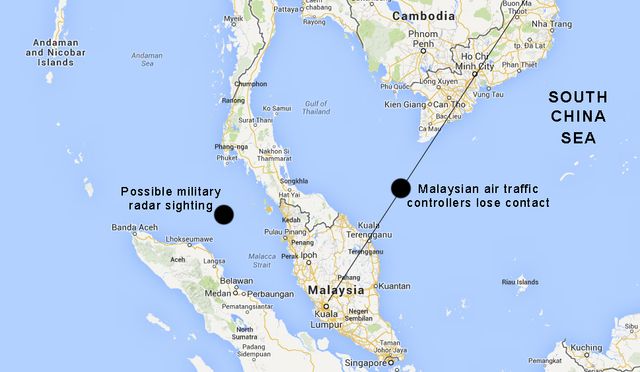Shrouded in Mystery: Conflicting Accounts of Vanished Malaysia Airline Flight 370

The fate of Malaysia Airlines Flight 370 and the 239 people on board remains shrouded in mystery, with slender and conflicting evidence and a rash of theories, magnified by the media, as to what took place.
The lack of clarity is further compounded by the various competing interests at stake—including Malaysia Airlines and Boeing, both seeking to protect their corporate images; the Malaysian government—under criticism over its search operations; and the Chinese government, which is under pressure to provide answers about the whereabouts of the many Chinese passengers on the flight.
The latest satellite images released by Chinese authorities showing a “possible crash area” has only added to the confusion. The pictures taken on Sunday show three large indistinct objects floating in waters south of Vietnam. They range in size from 13 by 18 metres to 22 by 24 metres. The location is relatively close to the northerly flight path taken by MH370, which took off from Kuala Lumpur early on Saturday morning, headed for Beijing. Air traffic controllers lost contact with the plane an hour later. The crew sent out no distress call.
While the images could provide a much-needed breakthrough, there is no confirmation that the three objects are part of the plane’s wreckage. Previous sightings by Vietnamese search planes of possible debris and large oil slicks proved to have no connection with an aircraft crash. A former US aviation safety director, Tom Haueter, told CNN he would be “surprised” if the objects came from a plane, saying anything of that size would not float. Another former US aviation official, Michael Goldfarb, was more optimistic, declaring that “it’s a high chance that they’re going confirm that these [are] pieces of wreckage.”
Diametrically opposed evidence comes from Malaysian military radar data that places an unidentified aircraft hundreds of kilometres to the west in the Malacca Strait or Andaman Sea. After conflicting reports from Malaysian authorities in previous days, Malaysian air force chief General Rodzali Daud confirmed yesterday that military radar detected an aircraft that could have been MH370 about 300 kilometres north of the Malaysian island of Penang. Daud could not confirm it was the missing flight. The radar data has been sent to US investigators for closer analysis.
If the report turns out to be correct, it only compounds the mystery. It would mean that MH370 took off and headed north from Kuala Lumpur and, for reasons unknown, turned abruptly to the west. At about the same time, the plane’s transponder malfunctioned or was turned off and Malaysia’s air traffic control lost contact. The aircraft continued to fly west, across Malaysia, and was last detected to the north of Penang.
Malaysian authorities clearly knew about the military radar data when they asked the Thai navy on Sunday to begin searching the Andaman Sea. Publicly, however, they made contradictory statements, adding to public confusion, the anger of relatives for news and consternation among the 12 countries involved in the search efforts.
Vietnamese authorities yesterday suspended search flights, demanding clarification, but later resumed their operations. In what amounted to a rebuke to Malaysia, the Chinese foreign ministry declared: “There’s too much information and confusion right now. It is very hard for us to decide whether a given piece of information is accurate.”
Media speculation about a possible terrorist hijacking was undermined after Interpol identified two passengers travelling on the flight on stolen passports. Both were Iranian citizens. Pouria Nourmohammadi Mehrdad, 18, and Delavar Seyed Mohammad Reza, 29, both appear to have been seeking to settle in Europe. Interpol secretary general Ronald Noble told the media: “The more information we get, the more we are inclined to conclude it was not a terrorist incident.”
One possible explanation for the MH370 disappearance has received little press coverage. Last year, the US Federal Aviation Administration (FAA) warned of a serious technical flaw in Boeing 777s, one of which was used in the flight. The FAA issued a worldwide alert over the dangers of cracking in the fuselage skin underneath the aircraft’s satellite antenna that could lead to decompression and render the occupants, including the crew, unconscious.
As reported in the Sydney Morning Herald, a posting on the Professional Pilots Rumour Network explained: “A slow decompression (e.g. from a golfball-sized hole) would have gradually impaired and confused the pilots before cabin altitude (pressure) warnings sounded… If the decompression was slow enough, it’s possible the pilots did not realise to put on oxygen masks before it was too late.” The site of the flaw could also account for the failure of satellite communications, including the aircraft’s transponder. If that happened, the plane could continue to fly on automatically or veer off course, with the crew and passengers unconscious.
The theory, of course, is speculative, but there are obvious reasons for both Boeing and Malaysian Airlines to downplay such a mechanical flaw. The FAA directive was issued after an inspection of a 14-year-old Boeing 777 discovered a 16-inch crack. The agency called for “repetitive inspections of the visible fuselage skin and doubler” to be incorporated into the routine maintenance schedule for the Boeing 777s worldwide.
When contacted by Fairfax Media, a Boeing spokeswoman declared that it was up to individual airlines, not the manufacturer, to follow FAA directives. The article indicated that it was not known if Malaysia Airlines had incorporated the directive into the maintenance schedule for its Boeing 777 fleet. The airline made substantial losses over the past three years and last year cut its maintenance costs. It has emphasised its good safety record and the experience of the crew flying MH370.


